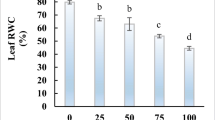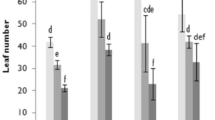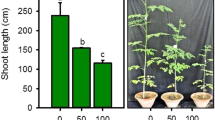Abstract
The use of plants and their products as sources of antioxidants to enhance health and food preservation is currently of great interest. Many plant species, especially those belonging to the Lamiaceae family have exhibited strong antioxidant activity. Salvia macrosiphon is an endemic medicinal plant in Iran, belonging to Lamiaceae family and has many pharmaceutical properties. This study was carried to evaluate the effects of different concentrations of sodium chloride [0.4 (control), 2.3, 4.5 and 6.8 dSm−1] on growth, total phenolic content and antioxidant activity of S. macrosiphon plants. Results showed that salinity stress affects plant growth by changing plants’ both fresh and dry weights. In addition, although total phenolic content in S. macrosiphon plants decreased with salinity, there was an increase in leaf antioxidant content. The absence of correlation between phenolic contents present in S. macrosiphon plants and antioxidant activity could be explained by the fact that other antioxidant molecules are also synthesized under stress conditions.


Similar content being viewed by others
Abbreviations
- DPPH:
-
1, 1-Diphenyl-2-picrylhydrazyl
- AGE:
-
Gallic acid equivalent
References
Amirghofran ZFZ, Javidnia K, Miri R (2010) The cytotoxic activity of various herbals against different tumor cells: an in vitro study. Iran Red Crescent Med J 12(3):260–265
Ardic M, Sekmen AH, Tokur S (2009) Antioxidant responses of chickpea plants subjected to boron toxicity. Plant Biol 11:228–328
Asada A (1997) The role of ascorbate peroxidase and mono dehydroascorbate reductase in H2O2 scavenging in plants. In: Scandalios JG (ed) Oxidative stress and the molecular biology of antioxidant defenses. Cold Spring Harbor Laboratory Press, New York, pp 715–735
Ben MT, Msaada K, Hosni K, Marzouk B (2009) Changes in fatty acid and essential oil composition of sage (Salvia officinalis L.) leaves under NaCl stress. Food Chem 119:951–956
Benzie IFF, Strain JJ (1997) Ferric reducing antioxidant power assay: direct measure of total antioxidant activity of biological fluids and modify ed version for simultaneous measurement of total antioxidant power and ascorbic acid concentration. Methods Enzymol 299:15–27
Blokhina O, Virolainen E, Fagerstedt K (2003) Antioxidants, oxidative damage and oxygen deprivation stress: a review. Ann Bot 91:179–194
Bruits M, Asres K, Bucar F (2001) The antioxidant activity of the essential oils of Artemisia Afra, Artemisia byssinica and juniperusprocera. Phytother Res 15:103–108
Dat J, Vandenabeele S, Vranova E, Van Montagu M, Inze D, Van Breusegem F (2000) Dual action of the active oxygen species during plant stress responses. Cell Mol Life Sci 57:779–795
Gohari AR, Ebrahimi H, Saeidnia S, Foruzani M, Ebrahimi P, Ajani Y (2011) Flavones and flavone glycosides from Salvia macrosiphon Boiss. Iran J Pharm Res 10(2):247–251
Halliwell B (2000) The antioxidant paradox. The Lancet 355:1179–1180
Hanato H, Kagawa T, Yasuhara T (1988) Two new flavonoids and other constituents in licorice root their relative astringency and radical scavenging effect. Chem Pharma Bull 36:1090–1097
Hirasa K, Takemasa M (1998) Spice science and technology. Marcel Dekker, New York, pp 163–200
Javidnia K, Miri R, Jamalia A (2005) Composition of the essential oil of Salvia macrosiphon Boiss. from Iran. Flavour Fragr J 20:542–543
Justesen U, Knuthsen P, Leth T (1998) Quantitative analysis of flavonols, flavones and flavanons in fruits, vegetables and beverages by HPLC with photodiode array and mass spectrometric detection. J Chromatogr 799:101–110
Karami M, Gohari AR, Naghshvar F, Salarnia A, Alemy SH (2012) Comparison effects of methanolic extracts of Salvia Macrosiphon and Withania Coagulans on Withdrawal syndrome in mice. J Pharm Sci 18(3):183–186
Kaur C, Kapoor HC (2001) Antioxidants in fruits and vegetables—the millennium’s health. Int J Food Sci 36:703–725
Misra N, Gupta AK, Dwivedi UN (2006) Changes in free amino acids and stress protein synthesis in two genotypes of green gram under salt stress. J Plant Sci 1:56–66
Namiki M (1990) Antioxidant/antimutagenesin food. Crit Rev Food Sci Nutr 29:273–300
Patro BS, Bauri AK, Mishra S (2005) Chattopadhyay, antioxidant activity of Myristicama labarica extracts and their constituents. J Agric Food Chem 53:6912–6918
Pellegrini N, Re Y, Yang M, Rice-Evans CA (1999) Screening of dietary carotenoids and carotenoid-rich fruit extracts for antioxidant activities applying 2,20-azino bis-3-ethylenebenzothiazoline-6-sulphonic acid radical decolorization assay. Methods Enzymol 299:379–389
Rice-Evans CA, Miller NJ, Paganga G (1997) Antioxidant properties of phenolic compounds. Trends Plant Sci 2(4):152–159
Scalbert A, Williamson G (2000) Dietary intake and bioavailability of polyphenols. J Nutr 130:2073–2085
Shannon MC, Grieve CM, Francois LE (1994) Whole-plant response to salinity. In: Wilkinson RE (ed) Plant-environment interactions. Marcel Dekker, New York, pp 199–244
Singleton VL, Rossi JA (1965) Colorimetry of total phenolics with phosphomolybdic-phosphotungstic acid reagents. Am J Enol Vitic 16:144–153
Tarchoune I, Sgherri C, Izzo R, Lachaal M, Ouerghi Z, Navari-Izzo F (2010) Antioxidant responses of Ocimumbasillcum to sodium chloride or sodium sulphate salinization. J Plant Biochem Physiol 48:772–777
Tarchoune I, Sgherri C, Baatour O, Izzo R, Lachaal M, Navari-Izzo F, Ouerghi Z (2012a) Phenolic acids and total antioxidant activity in Ocimum basillcum L. grown under Na2SO4 medium. J Med Plants Res 6(48):5868–5875
Tarchoune I, Sgherri C, Izzo R, Lachaal M, Ouerghi Z, Navari-Izzo F (2012b) Changes in the antioxidative system of Ocimum basillcum L. (cv Fine) under different sodium salts. Acta Physiol Plant 10:738–847
Tomaino A, Cimino F, Zimbalatti V, Venuti V, Sulfaro V, De Pasqualem A (2005) Influence of heating on antioxidant activity and the chemical composition of some spice essential oils. Food Chem 89:549–554
Vahdani M, Faridi P, Zarshenas MM, Javadpour S, Abolhassanzadeh Z, Moradi N, Bakzadeh Z, Karmostaji A, Mohagheghzadeh A, Ghasemi Y (2011) Major compounds and antimicrobial activity of essential oils from five Iranian endemic medicinal plants. J Pharmacol 3:48–53
Wang H, Cao G, Prior RL (1997) Oxygen radical absorbing capacity of anthocyanins. J Agric Food Chem 45:304–309
Yamini Y, Khajeh M, Ghasemi E, Mirza M, Javidnia K (2007) Comparison of essential oil compositions of Salvia mirzayanii obtained by supercritical carbon dioxide extraction and hydrodistillation methods. Food Chem 108:341–346
Author information
Authors and Affiliations
Corresponding author
Rights and permissions
About this article
Cite this article
Valifard, M., Mohsenzadeh, S. & Kholdebarin, B. Salinity Effects on Phenolic Content and Antioxidant Activity of Salvia macrosiphon . Iran J Sci Technol Trans Sci 41, 295–300 (2017). https://doi.org/10.1007/s40995-016-0022-y
Received:
Accepted:
Published:
Issue Date:
DOI: https://doi.org/10.1007/s40995-016-0022-y




